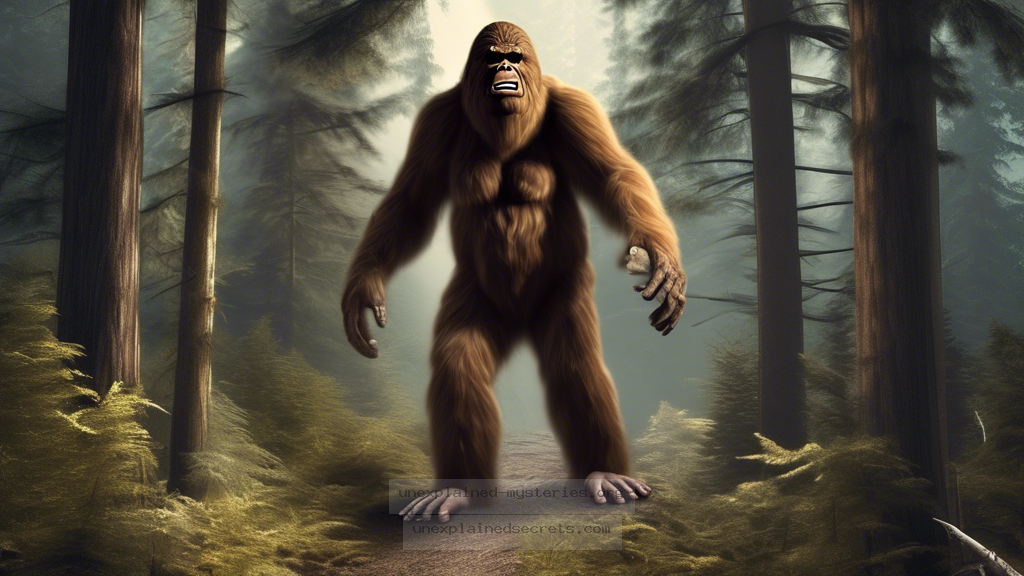What Are the Most Compelling Pieces of Evidence for Bigfoot’s Existence?
What Are the Most Compelling Pieces of Evidence for Bigfoot’s Existence?
The mystery of Bigfoot has intrigued humans for decades, leading to countless expeditions, documentaries, and debates among cryptozoologists and enthusiasts alike. As one of the most famous cryptids in the world, the question of whether Bigfoot truly exists remains unanswered. This discussion hinges on the evidence that has been presented over the years. What are the most compelling pieces of evidence for Bigfoot’s existence? Let’s delve into the historical context, core concepts, notable encounters, and the ongoing research surrounding this elusive creature.
Historical Context: The Legend of Bigfoot
The legend of Bigfoot, also known as Sasquatch, has its roots in Native American folklore. Tribes across the Pacific Northwest have long spoken of a large, hairy man-like creature living in the forests. These stories date back centuries, with various names given to the creature, like “Sasquatch” from the Salish language, meaning “wild man.” As European settlers arrived, they documented their encounters and reports of large footprints found in the wilderness, which fueled interest in the creature. The modern Bigfoot phenomenon began in the mid-20th century, particularly after the famous Patterson-Gimlin film was shot in 1967, purportedly capturing a Bigfoot walking through the woods of Northern California.
Core Concepts: What Constitutes Evidence?
When discussing the evidence for Bigfoot’s existence, it’s essential to define what constitutes credible evidence. In the realm of cryptozoology, evidence can range from eyewitness accounts and physical footprints to audio recordings and hair samples. The scientific community typically demands rigorous standards for evidence, including repeatability, peer review, and biological verification. However, the nature of cryptids like Bigfoot often makes it challenging to attain such standards, leading to a wide spectrum of claims, from the plausible to the absurd. Below, we categorize the most compelling evidence.
Eyewitness Accounts: A Mixed Bag of Testimonies
Eyewitness accounts form a significant portion of the evidence supporting Bigfoot’s existence. According to a survey by the Bigfoot Field Researchers Organization (BFRO), there have been over 10,000 reported sightings in North America alone. These accounts vary widely in detail and credibility, with some witnesses describing close encounters that left them shaken. For instance, in 2018, a couple reported seeing a large, hairy creature crossing a road in Washington State. They described it as being over 7 feet tall and covered in dark hair, moving with an agility that seemed impossible for such a large being.
💡 **Key Insight:** While eyewitness accounts can be compelling, they are subjective and often influenced by factors like fear, expectations, and environmental conditions.
Footprints: A Physical Trace of Existence
One of the most cited forms of evidence for Bigfoot’s existence is the discovery of large footprints. The first notable footprints were reported in 1958 when construction workers in Humboldt County, California, found enormous tracks in the mud. Since then, thousands of footprints have been reported across the United States and Canada, often measuring up to 24 inches in length. Some of these prints have been cast in plaster, allowing for detailed analysis. Skeptics argue that many of these footprints can be attributed to hoaxes or misidentified animal tracks, but a smaller percentage remain unexplained.
| Year | Location | Footprint Length | Notes |
|---|---|---|---|
| 1958 | Humboldt County, CA | 16 inches | First notable discovery |
| 2000 | North Carolina | 24 inches | Cast made of track |
| 2012 | Washington State | 18 inches | Multiple casts found |
Audio Recordings: Sounds from the Forest
Audio evidence has become increasingly important in the Bigfoot investigation. Many enthusiasts have reported hearing strange vocalizations in forested areas, which they believe could be attributed to Bigfoot. One of the most famous recordings is the “Sierra Sounds,” captured in the 1970s by researchers Ron Morehead and Al Berry in the Sierra Nevada mountains. The sounds consist of a series of howls, grunts, and strange vocalizations that are unlike any known animal. While some researchers argue that these sounds can be attributed to known wildlife, others maintain that their uniqueness suggests something more mysterious.
⚠️ **Caution:** Audio recordings require careful analysis, as many can be misidentified or manipulated, leading to false conclusions.
Hair Samples: Biological Evidence
Another intriguing area of investigation is the collection of hair samples believed to belong to Bigfoot. In 2012, a group of researchers in the Pacific Northwest collected hair samples that displayed unusual characteristics not consistent with known species. Analysis revealed a mixture of human and animal DNA, but the results were inconclusive. While some scientists are open to the possibility of discovering a new species, others remain skeptical, emphasizing the need for more rigorous testing and verification. The ambiguous nature of these findings continues to fuel the debate surrounding Bigfoot.
Historical Sightings: Documented Cases Over the Years
Throughout history, numerous documented cases of Bigfoot sightings have emerged, many of which have become part of American folklore. One notable case is the 1976 encounter of a California man named Ray Wallace, who claimed to have seen Bigfoot while camping. Wallace later fabricated wooden foot casts to prank his friends, but his story and the subsequent sightings helped cement Bigfoot’s place in popular culture. The 1980s saw a surge in reported sightings in the Pacific Northwest, further perpetuating the mythos surrounding the creature. Each account adds to the tapestry of Bigfoot lore, creating a fascinating exploration of human belief and experience.
Alternative Perspectives: Skeptics and Hoaxers
While many believe in the existence of Bigfoot, skeptics argue that the evidence presented is often circumstantial or fabricated. Numerous hoaxes have been exposed over the years, leading to public mistrust of claims surrounding Bigfoot. For instance, the 2008 revelation of a Bigfoot body hoax by two men in Georgia highlighted the lengths some individuals will go to capitalize on the phenomenon. Skeptics argue that the lack of conclusive physical evidence, such as a body or verified genetic material, supports the notion that Bigfoot is a myth or a misinterpretation of wildlife.
✅ **Notable Fact:** The BFRO and other organizations have developed criteria to evaluate sightings and evidence, which can help differentiate between credible claims and hoaxes.
Common Misconceptions: Debunking Myths
Many misconceptions exist around the topic of Bigfoot. A prevalent myth is that Bigfoot is solely a North American phenomenon; however, similar creatures are reported worldwide, with names such as the Yeti in the Himalayas and the Yeren in China. Additionally, people often believe that all sightings are hoaxes, but many credible witnesses have reported encounters, including law enforcement officers and park rangers. Understanding these misconceptions can lead to a more nuanced view of what Bigfoot represents in our culture and its potential existence.
Best Practices for Investigation: How to Study Bigfoot
For those interested in investigating the mystery of Bigfoot, several best practices can enhance the quality of their research. Firstly, documenting sightings with detailed notes, photographs, and videos is crucial. Engaging with local communities and drawing on their folklore can provide valuable insights. Utilizing technology such as thermal imaging cameras and audio recording devices can also yield compelling evidence. Finally, collaborating with experienced cryptozoologists can help guide investigations and ensure that findings are approached with an open mind and rigorous methodology.
Future Developments: Ongoing Research and Technological Advances
The future of Bigfoot research is promising, with advancements in technology and a growing interest in the field. The rise of citizen science has allowed amateur researchers to participate in data collection and analysis, contributing to a broader understanding of cryptid sightings. Genetic testing technologies continue to evolve, offering the potential for more definitive answers regarding hair and biological samples. Additionally, the integration of AI and machine learning in analyzing audio recordings and tracking sightings could provide new insights into Bigfoot’s behavior and habitat.
Conclusion: The Ongoing Mystery of Bigfoot
In summary, the question of whether Bigfoot exists remains a compelling enigma. Eyewitness accounts, footprints, audio recordings, and hair samples provide intriguing evidence, though each category has its own set of challenges. The historical context, ongoing investigations, and alternative perspectives all contribute to a rich tapestry of beliefs surrounding this legendary creature. As technology advances and research continues, the mystery of Bigfoot may inch closer to resolution—or perhaps, it will remain a fascinating element of human culture and folklore for generations to come. Whether one believes or remains skeptical, the search for Bigfoot invites exploration into the unknown, reminding us that not all mysteries are meant to be solved.
Other Articles
Recent Posts
- What Happened to Flight MH370? The Conspiracy Theories That Still Haunt Us
- What Secrets Lurk Within the Walls of the Infamous Trans-Allegheny Lunatic Asylum?
- What Evidence Supports the Existence of Bigfoot in the Pacific Northwest?
- What Happened to the Indus Valley Civilization? Unraveling the Mysteries of Ancient Urban Life
- Can Telepathy Be Scientifically Proven Through Laboratory Evidence?







